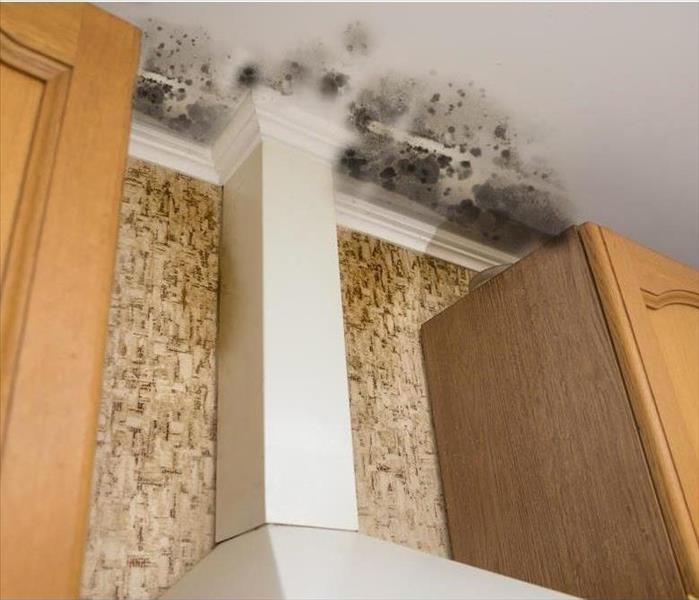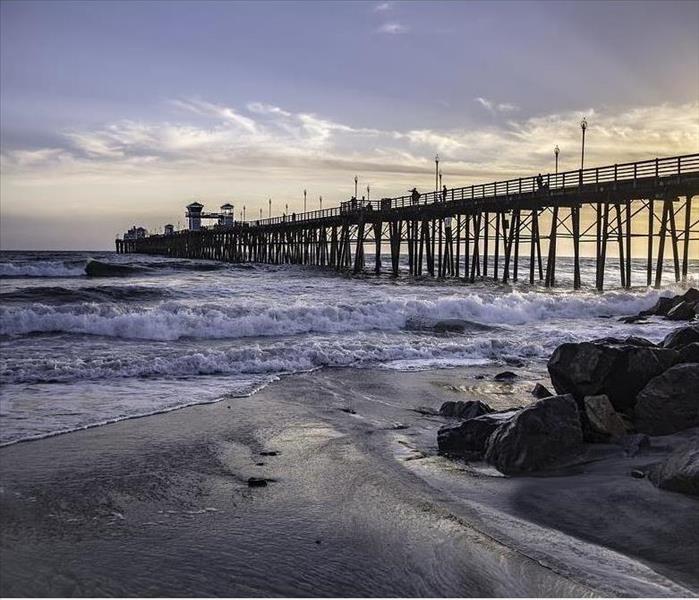Archived Mold Remediation Blog Posts
Spotting Mold: Protect Your Home and Health!
1/9/2025 (Permalink)
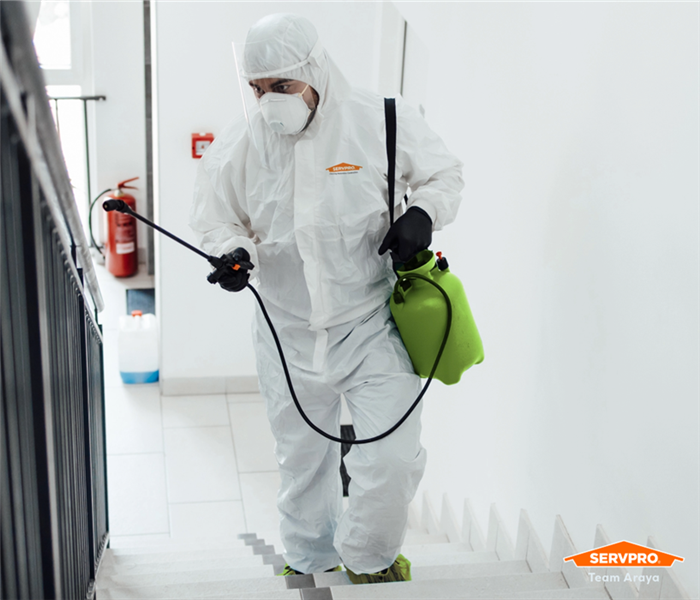 Our team removing mold
Our team removing mold
Mold can lurk in hidden corners of your home, causing damage and even affecting your health. But how do you know if it’s there? Look out for musty odors, dark spots on walls or ceilings, or unexplained allergy symptoms like sneezing and itchy eyes. Mold thrives in damp environments like basements, bathrooms, and under sinks. Ignoring these signs can lead to serious issues down the road.
At SERVPRO, we specialize in mold remediation services in the Fallbrook / South Oceanside to help keep your property mold-free. Our trained professionals are equipped to locate and eliminate mold swiftly and safely, ensuring your home stays healthy.
Don’t wait until mold becomes a big problem! Contact SERVPRO today for a thorough inspection! #1 restoration company in Fallbrook / South Oceanside.
How Does Mold Spread?
11/4/2022 (Permalink)
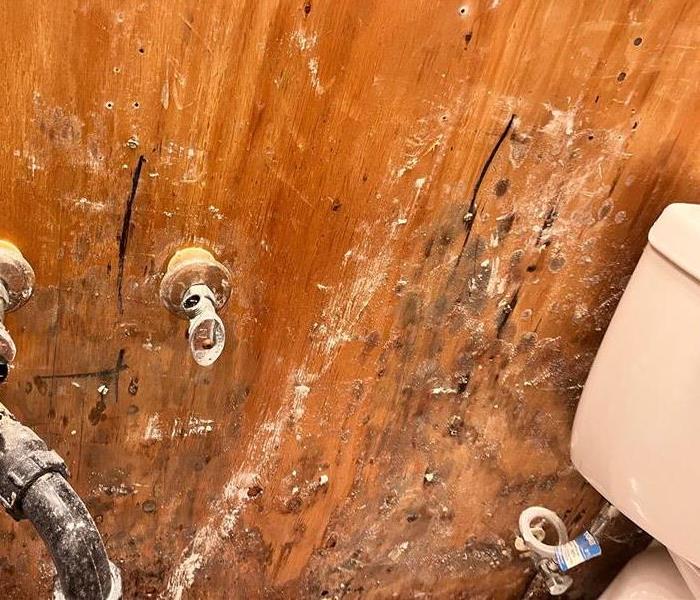 Mold growth on a stud wall after a water damage.
Mold growth on a stud wall after a water damage.
Mold is a common problem that many homeowners in Fallbrook, CA, must deal with at one point or another. In some cases, you may discover that it is growing in multiple locations within your house. If this is happening, then you may be unintentionally spreading mold throughout the building. The following are a few ways in which mold can spread.
1. Water Damage
Black mold needs moisture to grow, so if you are noticing the fungus in many different areas of the house, then it is likely you have multiple instances of water damage. This can be caused by something simple like a leaking pipe or may be the result of a storm. If this is the case, you should have the damage repaired quickly to prevent the mold growth from getting worse.
2. Air Conditioners, Fans and HVAC Systems
Mold grows from spores that are too small to see with the naked eye. This makes it easy for them to travel undetected through the air. If you have a growth in one area, the air circulation in your house might be spreading mold to other places. To prevent this, you should keep your HVAC system, fans and air conditioners turned off until the fungus is removed.
3. DIY Mold Removal
If you have tried to clean up a mold growth on your own, then it is possible you made the problem worse instead. Spreading mold after cleanup is easy to do if you don’t take the right preventative steps. The area should be thoroughly blocked off, and protective gear should be worn over your clothing, so you don’t accidentally carry spores to other areas.
Because mold is very easy to spread, it is a good idea to have a professional perform removal instead of attempting to do it yourself. A mold remediation company will have the necessary training, experience and equipment to get the job done well without spreading the fungus to other locations. They will inspect the home to find all areas of mold before doing cleanup and repairs.
Does Your Fallbrook or South Oceanside Home Have A Mold Problem?
2/5/2022 (Permalink)
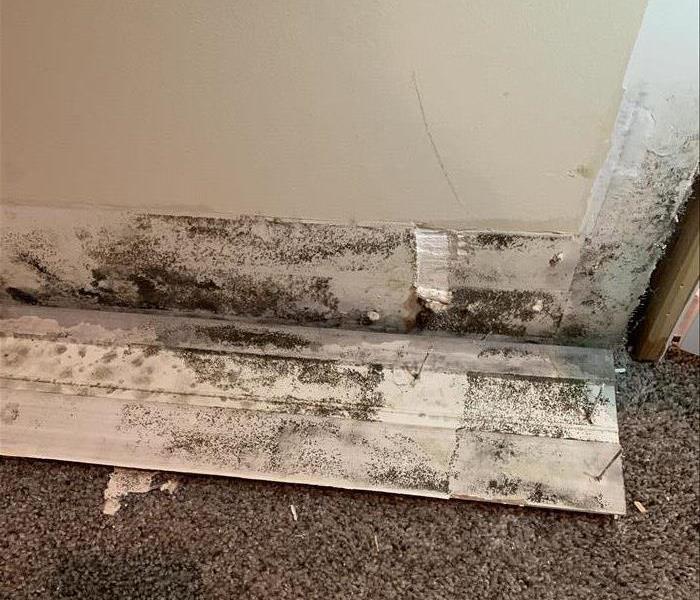 In Fallbrook or South Oceanside, mold can spread through a home in as little as 48 hours.
In Fallbrook or South Oceanside, mold can spread through a home in as little as 48 hours.
Microscopic mold spores naturally occur almost everywhere, both outdoors and indoors. This makes it impossible to remove all mold from a home or business. Therefore, mold remediation reduces the mold spore count back to its natural or baseline level. Some restoration businesses advertise “mold removal” and even guarantee to remove all mold, which is a fallacy. Consider the following mold facts:
•Mold is present almost everywhere, indoors and outdoors.
•Mold spores are microscopic and float along in the air and may enter your home through windows, doors, or AC/heating systems or even hitch a ride indoors on your clothing or a pet.
•Mold spores thrive on moisture. Mold spores can quickly grow into colonies when exposed to water. These colonies may produce allergens and irritants.
•Before mold remediation can begin, any sources of water or moisture must be addressed. Otherwise, the mold may return.
•Mold often produces a strong, musty odor and can lead you to possible mold problem areas.
•Even higher-than-normal indoor humidity can support mold growth. Keep indoor humidity below 45 percent.
If your home or business has a mold problem, we can inspect and assess your property and use our specialized training, equipment, and expertise to remediate your mold infestation.
If You See Signs of Mold, Call Us Today – (760)451-0600
Mold Remediation Standards
9/22/2020 (Permalink)
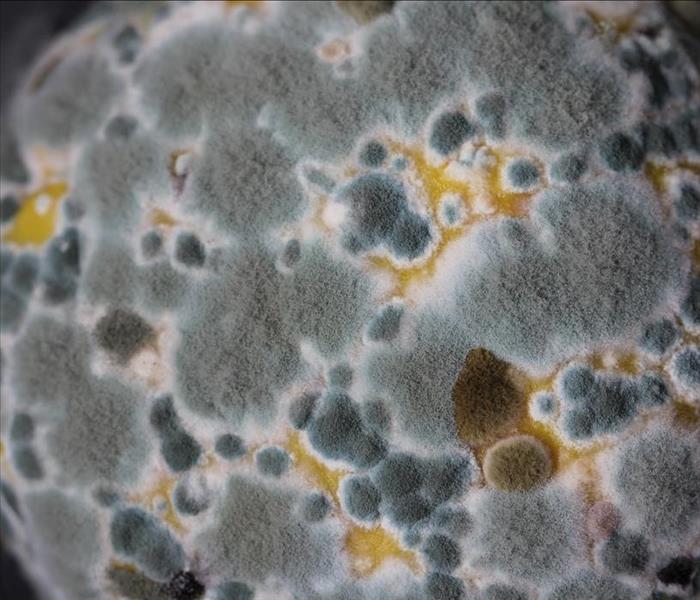 We take every precaution to ensure you are safe from mold exposure.
We take every precaution to ensure you are safe from mold exposure.
As the owner of a commercial building in Fallbrook, CA, you may wonder if there are specific standards for mold cleanup. It is important to familiarize yourself with mold standards for commercial buildings so that you can keep your business running smoothly.
Different Agencies, Different Standards
There are a few different agencies that publish standards relating to mold cleaning, including the following:
- Environmental Protection Agency (EPA)
- Occupational Safety and Health Administration (OSHA)
- Institute of Inspection, Cleaning and Restoration Certification (IICRC)
The EPA and OSHA provide guidelines to help you make sure your building is safe for yourself, your employees and the general public. The IICRC oversees certification of cleanup and restoration companies to help you find a company that will do the job right.
General Guidelines for Mold Cleaning
All three agencies publish detailed mold standards and update them regularly, but there are some best practices that are generally agreed upon throughout the industry. One such guideline is to work in a well-ventilated area and wear protective clothing because many types of mold, not just the infamous black mold, can cause health effects. Additionally, it is wise to locate and address the moisture source before beginning work; otherwise, the mold will return. Dry the area fully and then begin cleaning the mold. Diluted bleach will work for many surfaces, but a professional restoration team can select an appropriate cleaning method for delicate objects.
General Guidelines for Mold Prevention
After the mold has returned to normal levels, there are steps you can take to prevent re-infestation. You may wish to use mold-resistant painting and insulation. Additionally, air filters can reduce the amount of mold spores in the air. Keep humidity low, preferably below 50%, and perform regular maintenance on ductwork and HVAC systems. Check for mold regularly to address mold growth as quickly as possible.
Although mold in your commercial building is an unsettling thought, there are agencies that publish mold standards to help you address the problem quickly and correctly.
Can My Mold Artwork Be Saved?
9/23/2019 (Permalink)
 Humidity can ruin art and pictures
Humidity can ruin art and pictures
Learn More About Mold Cleaning Paintings
The impact mold can have in your home is vast. In addition to causing unsightly stains and smells, this fungus can literally eat away at the walls and surfaces of your home. But when your home includes valuable artwork, the impact can seem even more devastating. The good news is that even mold-damaged artwork isn’t automatically a loss. Learn more about mold cleaning for paintings and how to restore the artwork in your South Oceanside,CA home.
Understanding Mold Damage
Mold replicates due to heat and moisture. But it thrives on nutrients from organic surfaces. That includes wood, paper and even glue - key elements of paintings. Some of the damage mold can cause to art work includes:
- attacking frames
- eating away at canvases and paint
- staining canvases
Fortunately, there are lots of simple options for mold cleaning.
Cleaning Mold from Artwork
One of the most direct options is simply cleaning the artwork. Step one is spraying anti-germ or bacteria cleaner on the back of paintings. On the front, dabbing on rubbing alcohol mixed with water can help destroy mold. In the case of dry residue, a soft brush can work wonders - but be sure to use a HEPA filtered vacuum to clean any resulting mold dust.
Most important is drying the painting. If a painting isn’t dry, remaining spores can take up residence and the mold can return. Combat persistent moisture by setting artwork in the sun to dry, being careful not to leave it long enough to fade colors. For inside drying, place artwork near a window. In either case, put the artwork on a flat surface while drying to get the best results.
Mold damage is an art lover’s nightmare but it doesn’t have to destroy your investment. Use some of the mold cleaning tips above or reach out to a mold remediation specialist to get your art collection back in good standing.
Mold Cleanup Standards
7/25/2019 (Permalink)
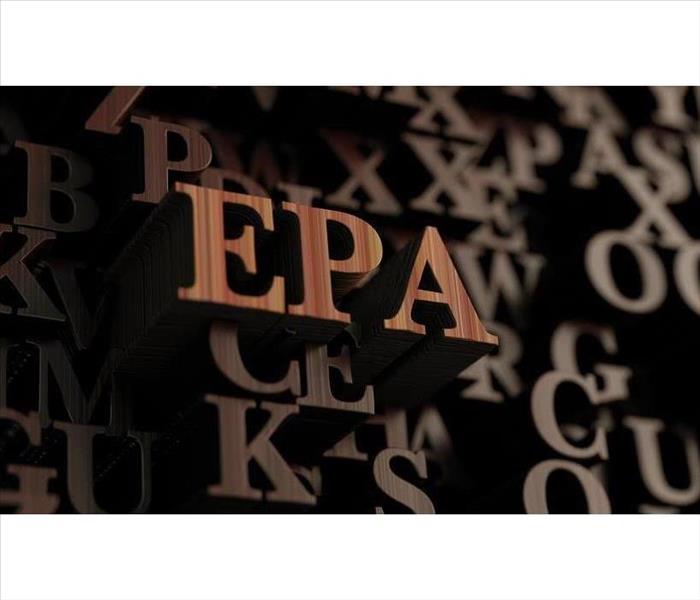 Environmental Protection Agency (EPA)
Environmental Protection Agency (EPA)
As the owner of a commercial building in Fallbrook, CA, you may wonder if there are specific standards for mold cleanup. It is important to familiarize yourself with mold standards for commercial buildings so that you can keep your business running smoothly.
Different Agencies, Different Standards
There are a few different agencies that publish standards relating to mold cleaning, including the following:
- Environmental Protection Agency (EPA)
- Occupational Safety and Health Administration (OSHA)
- Institute of Inspection, Cleaning and Restoration Certification (IICRC)
The EPA and OSHA provide guidelines to help you make sure your building is safe for yourself, your employees and the general public. The IICRC oversees certification of cleanup and restoration companies to help you find a company that will do the job right.
General Guidelines for Mold Cleaning
All three agencies publish detailed mold standards and update them regularly, but there are some best practices that are generally agreed upon throughout the industry. One such guideline is to work in a well-ventilated area and wear protective clothing because many types of mold, not just the infamous black mold, can negatively affect health. Additionally, it is wise to locate and address the moisture source before beginning work; otherwise, the mold will return. Dry the area fully and then begin cleaning the mold. Diluted bleach will work for many surfaces, but a professional restoration team can select an appropriate cleaning method for delicate objects.
General Guidelines for Mold Prevention
After the mold has returned to normal levels, there are steps you can take to prevent re-infestation. You may wish to use mold-resistant painting and insulation. Additionally, air filters can reduce the amount of mold spores in the air. Keep humidity low, preferably below 50%, and perform regular maintenance on ductwork and HVAC systems. Check for mold regularly to address mold growth as quickly as possible.
Although mold in your commercial building is an unsettling thought, there are agencies that publish mold standards to help you address the problem quickly and correctly.
3 Tips To Help You Deal With Bathroom Mold
6/6/2019 (Permalink)
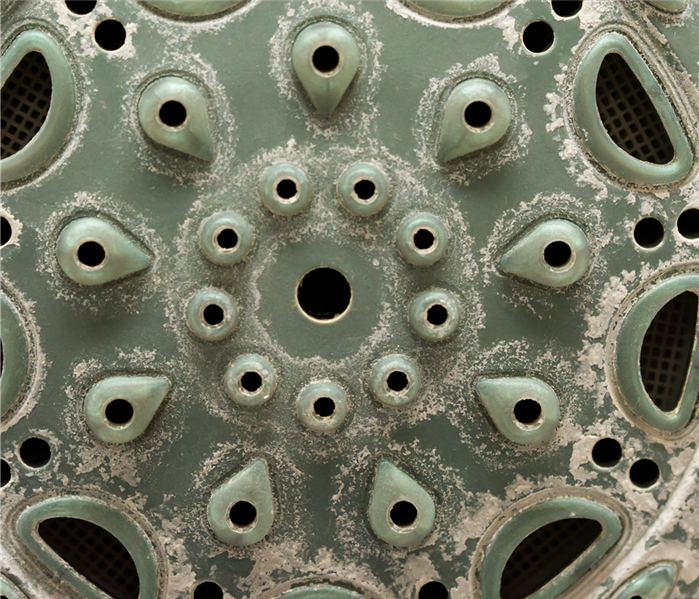 Shower mold in a South Oceanside, CA
Shower mold in a South Oceanside, CA
3 Tips To Help You Deal With Bathroom Mold
Most homeowners in South Oceanside,CA, experience shower mold at some point. Bathrooms are humid and not as well-ventilated as other areas of a house, making them a prime location for mold growth. There are several home remedies that are generally effective. However, if these don’t seem to be working, make sure to call a mold remediation specialist, as this is not an issue to ignore.
1. Bleach Walls and Tile
Many people already have bleach in their home, making this a convenient solution. This is simply a matter of mixing one part bleach to approximately ten parts of water and putting it into a spray bottle. Be careful with too much scrubbing, as you don’t want to release additional spores. Fortunately, this solution works pretty well, and you can usually just spray and wipe. Anytime you use a bleach solution, make sure to use gloves and eye protection. Always turn on the bathroom fan, and bring in another portable fan if your bathroom is still not well ventilated.
2. Replace Caulking
It can be especially difficult to remove black mold from shower caulking. Try scrubbing with an old toothbrush and the bleach solution. If that doesn’t work, it is probably time to re-caulk. Old caulking can be easily removed using a screwdriver or paint scraper. From there, apply new caulking and clean and dry it regularly to prevent future shower mold.
3. Prevent Future Problems
Not surprisingly, the best way to prevent a moldy shower is to keep it dry when it’s not in use. Keep a squeegee handy, and use it after showering to remove water from shower walls and doors. Keep the ventilation fan on for 5 to 10 minutes after a shower, and open a window if possible.
Shower mold can be a frustrating problem. However, there are steps you can take to deal with it and prevent future issues. If you use a bleach and water solution for cleaning, replace moldy caulking, and keep the area dry after showers, your mold problems should be behind you.
Can Mold Go Away on Its Own?
3/6/2019 (Permalink)
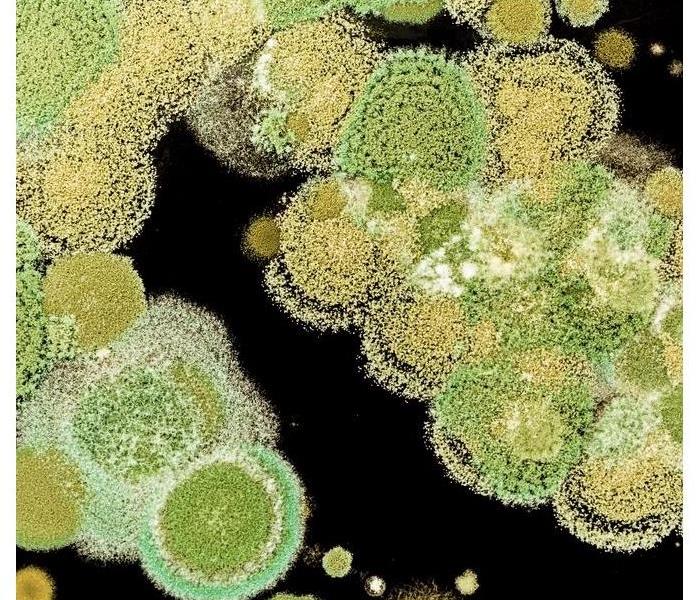 Water loss airflow quickens the evaporation of water making it difficult for settled spores to grow.
Water loss airflow quickens the evaporation of water making it difficult for settled spores to grow.
So, you had a moisture problem, smelly mold emerged, and you quickly swung into action removing standing water and drying surfaces. The area is dry, and the mold is gone – or is it? Many people think that once an area is dry and they can’t see mold, it’s gone. The fact is black mold doesn’t ever go away without targeted actions. If you’re wondering whether mold is truly gone from your South Oceanside, CA home, learn more about what it takes to eradicate mold.
How Mold Grows
Mold is one of those things nearly every homeowner will encounter. That’s because the things needed for it to grow are so pervasive. All this fungus needs to grow are:
The latter can be as simple as paper, drywall, wood or other organic matter. Eliminating mold is as simple as drying the area out, right? Not quite.
Dried-Out Mold Becomes Inactive
It’s true that drying a moldy area will stop active mold growth because spores need moisture to multiply. But this doesn’t impact the existing mold. So, while mold may not spread, it will continue to exist causing smells and unsightly stains.
Dried-Out Mold Can Become Active
Worse yet, if any sort of water makes it to the remaining fungus, can reactivate a patch of black mold. That means it can start producing spores again and new mold can appear.
Dried-Out Mold Needs to Be Removed
The fact is, whether dried or not, mold needs to be removed to prevent reactivation and new growth. To actually remove the fungus, you must clean nonporous surfaces that were contaminated and throw away porous materials.
Cutting out moisture is step one in eradicating black mold, but it’s not the end of the process. Work with a residential mold cleanup specialist to create a plan to truly eliminate mold and take your home bag from this bothersome fungus.
Common Causes of Mold Under Sinks
1/22/2019 (Permalink)
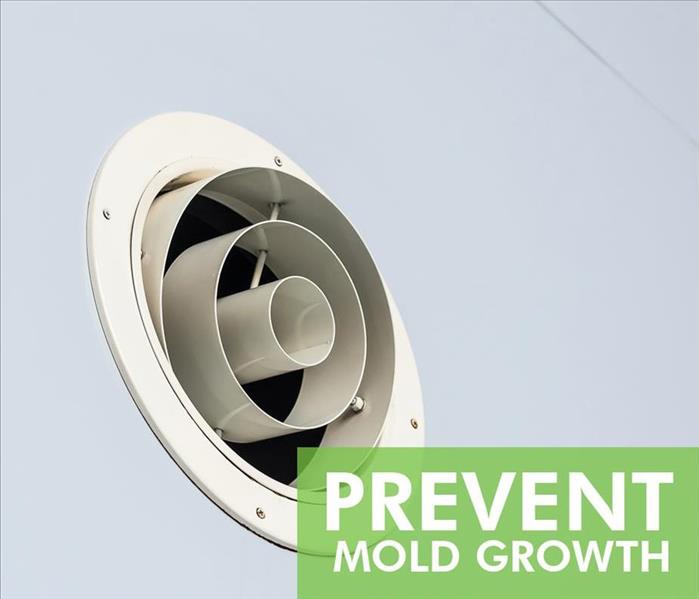 Bathrooms with a shower should be properly ventilated to prevent mold growth due to humidity
Bathrooms with a shower should be properly ventilated to prevent mold growth due to humidity
Common Causes of Mold Under Sinks
Whether it is caused by a leaking sink or other plumbing issues, mold underneath sinks in your home in Fallbrook,CA can be difficult to spot until major damage has occurred. However, knowing common causes of mold growth under sinks can make it easier to take preventative steps.
1. Leaks
Mold requires access to organic material and water in order to thrive, and when a pipe is leaking, this creates an excellent environment for mold to grow. Mold can grow on various areas under sinks and can grow in a span of only one or two days in the right conditions. In order to prevent mold from causing major damage, it’s often helpful to fix the leak as soon as possible.
2. Issues with Appliances
Though a leaking sink can, of course, cause mold to grow under sinks, there are other plumbing problems that can also result in mold growing underneath your sinks. Since sinks are often placed near other appliances in bathrooms or kitchens, it’s possible that water is coming from leaks in other appliances, such as from a dishwasher. Additionally, if the sealant wears down over time, loose caulk could allow for water to drip underneath the sink.
3. High Humidity
Sinks are generally necessary in kitchens and bathrooms, but these areas in the home are often the perfect places for mold to grow. In bathrooms, humidity levels rise when someone takes a warm bath or shower, and in kitchens, humidity levels are higher when food is boiled or steamed. To keep the humidity at an acceptable level to prevent mold growth, it’s often wise to use dehumidifiers in these areas.
Understanding that a leaking sink, faulty appliances and high levels of humidity can cause mold to grow under sinks should make preventing mold easier. However, if your home is experiencing major mold problems, consider contacting mold remediation professionals.
Assess Mold Damage in 4 Steps
9/17/2018 (Permalink)
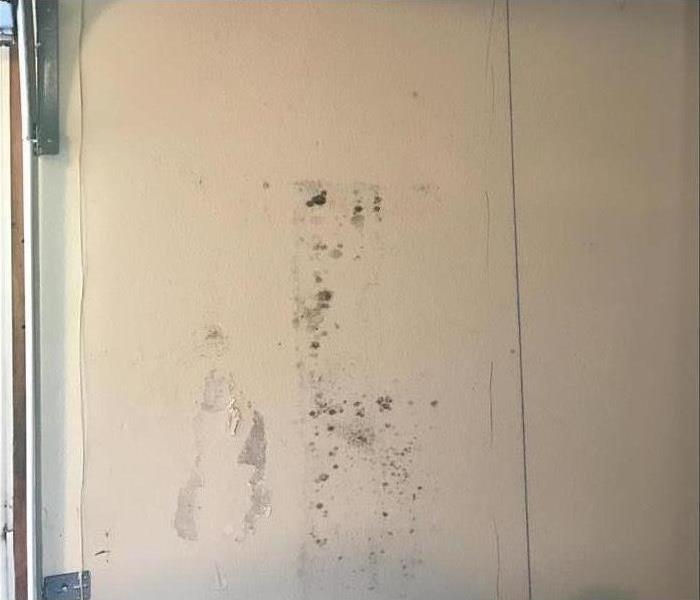 Mold damage in a South Oceanside, CA home
Mold damage in a South Oceanside, CA home
Mold can multiply rapidly when moisture is present in a residence. These four mold assessment steps will lead you from detection to identification, resolution, and remediation of a mold or mildew problem in your home. You can begin to inspect readily accessible areas, but you should never attempt to find hidden mold. For the best results, you should hire a certified specialist or hygienist.
1. Determine Whether Mold is Present
The first step to assessing mold damage is to determine whether mold is growing in a home. If you do not see any visible mold, contact a certified specialist to continue the search. Never attempt to cut holes in walls, floors, or other structural surfaces, or peel wallpaper to check for mold on your own. In doing so, you may expose yourself and other residents or help these spores spread throughout your home.
2. Identify the Type and Extent of Growth
A mold expert or hygienist can locate mold and perform tests to identify the particular type of mold in your home. Keep in mind that black mold is not always black in color. Mold assessment is a job best left to trained experts.
3. Address the Source of the Problem
The primary source for mold or mildew growth is the presence of moisture within a structure. You will need to take steps to fix a leak or dehumidify areas prone to dampness to prevent mold spores from starting to multiply.
4. Inspect Damaged Contents
Some contents or items damaged by mold will need to be safely disposed of and replaced. Mold remediation specialists can help you determine which items are capable of being restored.
These four mold assessment steps can guide residents through every step of the process. If you are dealing with mold in your home in South Oceanside,CA , hire a certified specialist or hygienist and remediation experts.
Get Your Home Mold Problem Under Control
5/15/2018 (Permalink)
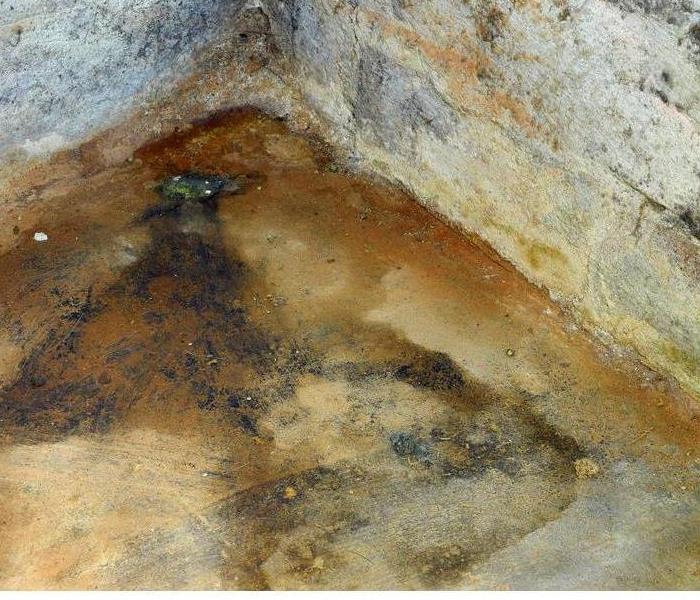 Give SERVPRO a call if you notice mold growing in your home.
Give SERVPRO a call if you notice mold growing in your home.
Many think of mold as an outdoor problem, but in truth, there’s no such thing as a mold-free home. There’s only a home free of the conditions required to allow mold spores in the air to flourish and grow. That’s why you can take precautions to keep your South Oceanside, CA home from turning into a breeding ground for black mold.
Prevention First
You don’t want to have a mold problem and then figure out how to fix it. It’s better to never have a mold problem at all through dedicated mold prevention. Water damage is one of the major culprits in mold growth; if you have mold, odds are you have a leak or have recently suffered flood damage. Here are a few ways to check for water damage that can lead to mold.
• Watch for dark spots on walls and ceilings. Dark spots are usually water damage caused by leaking roofs and windows, sometimes by damaged or leaking pipes. Don’t forget to check for out-of-the-way places, such as under sinks.
• Listen for dripping pipes and inspect periodically. As mentioned, damaged and leaking pipes can create an environment ripe for mold growth.
• Eliminate standing water. You might not think much of getting out of the shower and leaving a dripping mess, but that water can seep under your bathroom floor tiles and start mold breeding underneath the linoleum. Look for other sources of standing water, such as splashed dishwater or leaks beneath appliances.
• Control humidity. Your bathroom fan is a great way to get rid of mold-causing steam and condensation; your stove should also have a fan for the same reason. If your environment is extremely humid, invest in a dehumidifier.
Remediation Next
When mold prevention isn’t enough, you need remediation next. Mold remediation involves professionals assessing the extent of your mold problem and taking steps to eliminate as much as possible from your environment. Mold remediation specialists can also offer advice on further prevention after a cleanup. Visit http://www.SERVPROfallbrooksouthoceanside.com for more information on mold.
3 Strategies for Preventing Mold in Your Restaurant
4/30/2018 (Permalink)
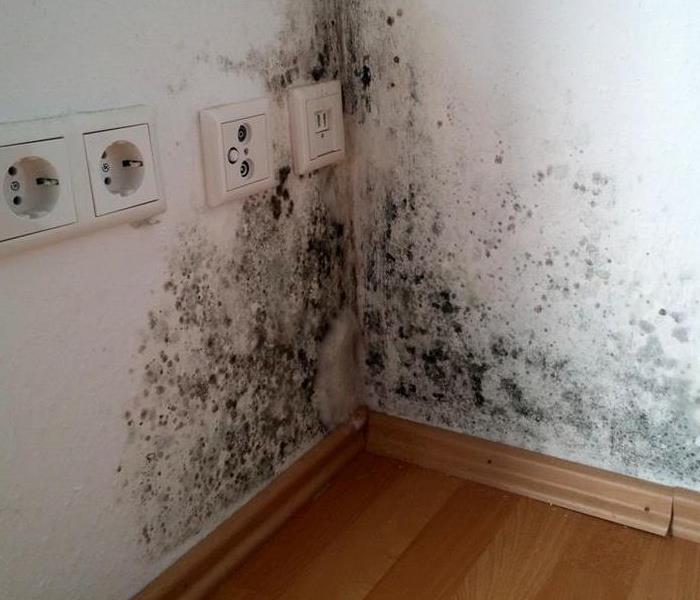 Call SERVPRO if you notice mold growth in your business.
Call SERVPRO if you notice mold growth in your business.
Keeping your Fallbrook, CA restaurant clean is probably a high priority for you. Not only is cleanliness necessary for following local and federal food handling guidelines, it can make a positive first impression on customers who come to dine for the first time. One major factor in keeping your restaurant clean is preventing mold growth, and there are several strategies you can use to help keep your business fungi free.
1. Keep Humidity Low
High humidity can contribute to the development of mold, especially in spaces where there is also plenty of moisture. Your walk-in coolers, dishwashing areas and prep areas may all be vulnerable, so monitoring the environment in these areas is wise. Ensure that there is plenty of ventilation, keep windows open and mop up dishwashing or prep food water spills right away so mold does not have the chance to take hold and spread.
2. Maintain Your HVAC System
Mold spores exist naturally in the air; however, when they are given the right environment in which to settle and grow colonies, their spread can happen quickly. These spores can travel faster when they invade your HVAC system, so having it checked, cleaned and maintained at least twice a year can go a long way in preventing mold. Have a qualified technician check for air conditioning leaks that may encourage mold growth and have repairs or improvements made as needed.
3. Have Your Building Inspected for Leaks
Hidden leaks in your restaurant can create significant water damage over time and give mold the ideal environment in which to thrive. To find and resolve leaks, call in a qualified water damage and restoration company that can also advise you on how to solve any water leakage issues. Remember to have both the inside and outside of your property inspected, especially if you run water lines to manage patio misters or other water features for your restaurant.
One important aspect of keeping your Fallbrook, CA restaurant clean is preventing mold growth. Fortunately, taking a few simple proactive steps can stop the growth of fungi before it affects your business. Visit http://www.SERVPROfallbrooksouthoceanside.com for more information on mold.
Mold in a Nutshell
3/26/2018 (Permalink)
You’ve probably seen it, and you probably know that it’s not something you want on your food, on your walls or on your floors. We’re talking about mold, and it’s not something you want to deal with in your South Oceanside, CA home. There are several forms of mold and a number of ways it can infiltrate your home or place of business. It’s important to understand what it is, how it develops and what you can do to effectively handle mold cleanup.
A Fungus
Interestingly, mold come about from tiny spores from the air. These spores will float about and can land just about anywhere in your home. Ordinarily, mold will grow where there is a moisture problem, such as damp basements, showers or refrigerators.
Mildew
You’re no doubt familiar with mildew, as you’ve probably run into this issue in your South Oceanside, CA bathroom. It has the appearance of small black spots and usually shows up on shower tile or shower doors. If you ignore mildew, it will continue to build up, creating an unattractive appearance. Fortunately, it’s easy to get rid of this issue:
• Grab a cleaning brush with strong bristles
• Get a commercial-grade bathroom cleaner and apply to the affected area
• Scrub firmly until the mold comes off
Black Mold
In a list of all the types of mold you may see in your home, this is probably the type you want least. This form of mold can be problematic, so you should never touch it or even go close to it. If you find this in your home, call a specialist immediately.
Once you understand what mold is and how it can find its way into your home, you’ll have a much easier time getting rid of it. Black mold, especially, is a major concern that you should leave in the hands of a competent professional. Visit http://www.SERVPROfallbrooksouthoceanside.com for more information on mold.
Mold and Mildew: Bad Smells and Where To Find Them
2/19/2018 (Permalink)
Building owners in South Oceanside, CA quickly realize that mold is much easier to smell than it is to locate. The mold smell can be strong and overpowering without being directly visible, leaving you to wonder just where exactly it’s coming from. Following is a discussion about what causes a mold smell, mildew smell, fungus smell or any variety of the three and how best to find the sources throughout your commercial property.
What Makes Mold and Mildew Odor So Distinct?
Mold and its similar species are quick to grow in areas with a lot of moisture and humidity. Mildew and mold thrive in such places as they’re both different kinds of fungi that need the presence of water to survive and multiply. These fungal inhabitants create their smells through the basic function of their existence, meaning any time they eat and reproduce the smell becomes stronger. Mildew brings less of an odorous presence with lighter, musty smells, but moldy smells become quite overbearing the more they continue to grow and spread around your building.
Where Can You Find Non-Visible Mold on Your Property?
The mold smell itself often leads you closer to its original growth point, though it’s not always an exact indicator. Thermal cameras are available these days to help find previously undetected sources of water, but mold is generally found in common areas like:
*Kitchens, bathrooms and other sources of consistent water usage
*Air conditioning units or water heaters
*The walls below leaky windows or door frames
*Cellars or basements where light to heavy flooding occurs regularly
*Refrigerators or freezers that create high condensation in dark corners
When you’re trying to find the presence of mold in your South Oceanside, CA property, following your nose towards the mold smell is a great first step. However, removing the fungus smell, mildew smell and any other similar odors that are harder to pinpoint requires checking these suggested places to find their non-visible locations. Once the mold is found, call remediation specialists to clear out your building. Visit http://www.SERVPROfallbrooksouthoceanside.com for more information on mold.
The Importance of Cleaning Mold Quickly
1/18/2018 (Permalink)
Spot mold on your walls or carpet, and your first instinct might be to leave your commercial property and call a mold remediation company. While the unsightly stains might seem bad enough, there are other, more important risks to keep in mind. Check out these three reasons why you should schedule a mold cleanup as soon as possible after a pipe burst.
1. It Can Spread
Wet, warm and humid conditions make mold thrive. Water from a broken pipe can cause mold to sprout if it's left standing longer than 24 hours. It does so by releasing microscopic spores into the air that can travel all over your property. If the problem is left unattended, it can spread to several rooms. Depending on the location of the damaged pipe, you might be encouraging it to grow every time you turn on a sink or flush a toilet.
2. It's Unhealthy
Breathing in mold can have negative health effects, especially among the young or elderly. Black mold in particular may even result in visits to a doctor. Mold remediation specialists will tackle an outbreak from several angles to make sure you, your employees and your clients remain safe.
3. It's Unsightly
Mold can create stains that set in your carpet and walls. Simply drying the water from a pipe burst is often not sufficient to get your business back in optimal condition. Experts might need to install new flooring or drywall to remove all traces of an infestation. Business owners in Fallbrook, CA who allow mold to fester end up paying a significant amount of money repairing their property.
A pipe burst shouldn't be taken lightly. The mold that can result might be viral, unhealthy and aesthetically damaging. Schedule an emergency mold cleanup quickly after a disaster to make your commercial property safe.
Visit SERVPRO of Fallbrook/South Oceanside at http://www.SERVPROfallbrooksouthoceanside.com/ for more information about mold restoration.
Mold Prevention Tips
12/15/2017 (Permalink)
Mold Prevention Tips
Once you have mold in your South Oceanside, California home, you have no options but to have it removed. However, once you do that, it is a good idea to have a plan in place to stop mold from growing again. Having to constantly call in a mold remediation company to tackle your mold growth issues is not something you want to have to do. Here are some tips on how to stop mold growth in your home due to water damage.
Tackle Water Damage
Moisture is the best friend of mold. It is what allows it to begin growing. In a home, the biggest cause of moisture is water damage. This could be from a leaky roof, window or door. It could also come from plumbing issues or water getting into your home due to flooding. The important thing is for you to figure out how the water is getting in and to stop it. Do the following:
Fix roofing, broken windows or ill-fitting doors.
Address plumbing issues as soon as possible.
Have inspections done of floors, walls and ceilings after a water leak.
Waterproof your basement to prevent leaks.
You should always handle any moisture issue as soon as possible.
Take Mold Prevention Steps
You should also focus on taking steps to prevent mold from growing. This means ensuring the spores cannot grow and cannot spread. Mold spores travel in the air, so one of the best mold prevention steps is to clean your HVAC system. Mold spores can get trapped and then carried throughout your home every time your system runs. If humidity is the issue, get a dehumidifier to keep levels low. This will help keep moisture levels from getting too high in your home.
When it comes to mold in your South Oceanside, Californina home, you need to make sure you take proactive steps to ensure you never have a problem. Dealing with mold can be a hassle, not to mention how dangerous it can be to your home and property. A few mold prevention steps can go a long way towards keeping your home a healthy space. Visit http://www.SERVPROfallbrooksouthoceanside.com for more information on mold.
Mold & Mildew, Understanding the Key Differences and Health Concerns
11/1/2017 (Permalink)
Mold and mildew are common problems, especially for homeowners who live in moist conditions or own properties by the coast. Mold and mildew are serious concerns in many parts of the country, but residents of Southern California, including the community of Oceanside are at special risk.
Mold and mildew are serious problems, and any kind of mold and mildew is unsightly. If you have mold or mildew in your home, your number one goal should be to have it removed as soon as possible. Even non-toxic mold can damage your home and harm the structural integrity of your property, but some forms of mold can actually put your health, and the health of your family at risk.
Understanding Mildew
Mold and mildew are both fungi, a classification that also includes mushrooms. Like mushrooms, mold and mildew thrive in moist conditions, including damp basements and places where water has been allowed to accumulate.
Mold and mildew also spread quite easily, so once the problem takes hold, it can be very hard to cure without professional advice and guidance. A small patch of mildew growing on your bathroom wall could easily grow out of control if you leave it alone, so you should not wait if you see the telltale signs.
Mildew is actually a type of mold, one with a flat growth pattern that generally remains on the surface where it is growing. That flat growth pattern makes mildew easier to remove than other types of mold, although professional remediation is still strongly recommended.
What is White Mold?
White mold, on the other hand, is what you see growing on food that has been left out too long. If you ever cleaned your fridge and found mysterious white hairs, you were probably looking at white mold.
White mold also grows easily on walls and crawlspaces, and inside permanent structures. You should look carefully for this common type of mold every time you clean, and definitely every time you go in your basement or crawlspace.
Mildew, on the other hand, is typically found on damp surfaces, including wallpaper that has been exposed to moisture, fabrics and various moist spaces around your home. While mildew is not as dangerous as some other forms of mold, however, it is still unsightly and it can still trigger reactions in those with respiratory conditions or compromised immune systems.
Types of Household Mold
There are a number of common mold types that invade houses, but those household molds are only a small subset of the mold varieties that exist in nature. More than 10,000 species of mold can survive indoors, but most homeowners will see only a handful of those varieties.
Some of these mold species can be quite harmful, but the most common form of dangerous mold is toxic black mold. Also known as Alternaria, toxic black mold typically grows on shower enclosures, on walls, under sinks and around windows. Toxic black mold can also take hold in other damp places, including basements and crawlspaces with a history of past flooding.
Alternaria
Despite its common name, Alternaria mold is not always black. Toxic black mold can also appear dark brown or grey, but no matter what its color it typically has a down-like or wooly texture.
Prolonged exposure to toxic black mold can trigger asthma attacks, allergic reactions and other serious health problems. If you suspect that black mold is growing in your home, you should contact a mold remediation specialist as quickly as possible. Like all forms of mold, toxic black mold grows quickly, and the health problems will get more serious as the mold spores grow larger.
Aspergillus
Aspergillus is another common form of mold, and it is sometimes mistaken for the more serious toxic black mold. Like toxic black mold, Aspergillus can be grey, brown or black, but it may also appear in colors like yellow, green or white.
Aspergillus mold generally grows on insulation, paper products, walls and clothing. Like toxic black mold, Aspergillus can trigger an allergic reaction and cause problems for those with weakened immune systems and preexisting respiratory problems.
Cladosporium
While most molds grow best in warm humid conditions, Cladosporium grows well in cool areas. This type of mold generally shows up on fabrics, including curtains and carpets, as well as wooden surfaces like floorboards and cabinetry. Cladosporium is typically black or olive green in color, and it can also trigger a number of respiratory conditions.
Penicillium
In the right venue, Penicillium is a lifesaver, but in your home it can be a problem. As the name implies, Penicillium is the mold that was originally used to make lifesaving antibiotics, and it is still an important drug.
Unfortunately, penicillium also grows well on surfaces that have been exposed to water, including carpets, wallpaper, insulation and old mattresses. Penicillium is typically blue or green, and it has a distinctive strong musty odor. Like other forms of mold, penicillium exposure can trigger allergic reactions in vulnerable people.
Stachybotrys Chartarum
You may hear Stachybotrys chartarum referred to as black mold, mainly because of its distinctive color, and this is the most serious and most dangerous form of household mold. That danger has earned Stachybotrys chartarum its other moniker - toxic black mold.
Unlike other forms of household mold, which are unsightly and dangerous mainly to those with respiratory problems and damaged immune systems, Stachybotrys chartarum releases a number of toxic compounds, and these compounds can be dangerous even to healthy adults and children.
These toxic compounds are known as mycotoxins, and they can produce some very serious health problems. These health issues include chronic sinus infections, difficulty breathing, asthma attacks, allergic reactions, depression and fatigue. If you or a family member has experienced any of these symptoms, you should have your home examined for toxic black mold.
A mold remediation expert can check your home and look for the telltale signs of toxic black mold. Toxic black mold has a distinctive musty odor, and it typically grows in places that are consistently damp, like basements prone to flooding, crawlspaces with water intrusion problems, around leaking pipes and inside of air conditioning ducts.
If you discover mold or mildew growing in your home, time is of the essence. Contacting a professional mold and mildew remediation service right away can mean the difference between a simple repair and months of hard work and expense.
When you have mold problems, you need the help of a trained professional, and you can find that professional at SERVPRO of Fallbrook / South Oceanside. We can help you protect your home and the integrity of your property, and we have the expertise needed to safeguard the health and family. Just give us a call at (760) 451-0600.
Pacific Coast and Oceanside Home Mold Removal and Remediation
9/22/2017 (Permalink)
Oceanside Mold Removal & Remediation
Living near the ocean can be a wonderful experience, with cool breezes, spectacular views and a laid-back way of life that is hard to beat.
Whether you are new or a native to living in Oceanside or the surrounding areas, you know how wonderful it is to have a place you can call home that is near the Pacific.
Unfortunately, coastal living also comes with its fair share of dangers, and mold is chief among them. Finding mold growing in your Oceanside home can be devastating, and knowing what to do in that situation can be quite difficult.
Contact Your local professionals at SERVPRO of Fallbrook / South Oceanside. Our team of mold experts are dedicated to helping rid homes throughout Oceanside and North County San Diego of mold.
We have experienced mold removal and remediation specialists ready to help, give us a call at (760) 451-0600.
Highly Qualified Mold Removal & Remediation Process
Mold removal from your Oceanside home is a very specialized process, and not one homeowners should try to tackle on their own. At first blush, the process of mold removal and remediation can seem like a simple one, but it is anything but. Mold cleanup is a time-consuming process, an exacting one, and trying to clean up mold on your own could end up making the problem even worse.
The Risk Of Mold In Oceanside
The very conditions that make living in Oceanside or along the Pacific Coast Highway so wonderful are the same ones that make mold a problem. Your beautiful views of the Pacific ocean are often accompanied by coastal moisture, warm temperatures and with humidity your Oceanside home provides a ready breeding ground for mold, including many varieties that can cause serious illness in humans and animals. You would not want to find black mold growing in your Oceanside home.
If you suspect your home needs mold clean up, you should not risk waiting. While some varieties of mold are merely unsightly, others are downright dangerous. You cannot tell by the naked eye which type of mold your home is harboring, so it is important to call an experienced Oceanside mold specialist with SERVPRO at (760) 451-0600 at the first sign of trouble.
Signs Of Mold Growth
So how do you know if you have a mold problem in your Oceanside home? While every property is different, there are a number of signs to watch out for. You should call a professional mold remediation specialist right away if you notice any of the following:
Musty Smell
Mold gives of a distinctive odor, but you may not recognize it if you have never dealt with oceanside mold removal before. If you smell a musty odor in your home, you should suspect a mold problem.
Visible Mold
Visible mold growth is the most obvious sign, but it is not as easy to spot as you might think. If you spot dark streaks or other signs of mold growth, you should contact a mold remediation specialist right away.
Leaking Water
If your coastal home has a water problem, it probably has a mold problem as well. Mold thrives in moist conditions, and if you see standing water, unusual drainage or water leaks, some sort of mold clean up is probably in your future.
Condensation and Moisture
Watch for spots where water accumulates in your home, especially in the basement or crawlspace. If you see condensation in these areas, you could have a growing mold problem, and an immediate need for emergency mold removal.
History of Flooding
If your coastal home has ever flooded, the property is at increased risk for a mold problem. This elevated risk of mold exists even if the flooding was relatively minor, and the best defense is eternal vigilance. If you spot any signs of mold in or around your home, your next call should be to an experienced Oceanside mold removal specialist.
If you spot any of the above telltale signs and symptoms, you may very well have mold in your Oceanside home.
Experienced Oceanside Mold Remediation
Contact SERVPRO of Fallbrook / South Oceanside and speak to our mold remediation expert immediately. Having mold in your home and letting it linger can be a very risky bet for both you and your family. Young children are especially vulnerable due to their age their immune systems and bodies are not as strong as adults. Our team of mold remediation experts in Oceanside are parents and know full well the dangers of mold. Our team is trained and qualified in how to properly remove the mold from wherever it is growing and clean the air of mold spores returning your home to normal.
Contact Us Today
If you need to get rid of mold, you need expert advice and guidance. Contact us today, (760) 451-0600 and we would be happy to help. Mold removal is not a do-it-yourself project you should rush into and you cannot rely on your own expertise to get rid of mold and protect your family and home.
Our Oceanside mold remediation experts will be there every step of the way to explain what is being done to restore your home.
Mold Removal: How to Safely Get Rid of Mold From Your Home
8/21/2017 (Permalink)
Mold Removal: How to Safely Get Rid of Mold From Your Home
Mold removal involves the process of getting rid of any visible mold in a building. This is an important process for an infested building since it maintains a healthy environment for the occupants and reduces further spread. Before mold removal and remediation can take place, it's important to get to the cause and ensure proper mitigation or else the mold growth will still re-occur. It's also important to note that the remediation of mold damage can be complicated or simple depending on the type of building, the level of contamination, and also infestation.
When the mold in a home covers an area of more than 10 square feet, then you will need to seek the help of a commercial mold damage expert for the mold growth removal and deodorization services. Whether the removal of black mold, mildew, dry rot, or fungus is performed in the bathroom, basement, or attic, it's important to ensure proper mitigation so that it doesn't spread to other non-contaminated areas. The restoration company will guide you through.
The level of contamination also plays a role in the amount you have to pay and whether you will need to seek the services of a commercial mold restoration company. Also, it's important to remember that it's the amount of settled spores and the type of mold, mildew, or fungus that matters. If you suspect that you're having a mold problem but you don't see any visible dry rot or black mold growth you should consider testing the air.
Steps to effective mold removal
Before cleaning the mold damage, you should determine whether the mold growth behind the wall, attic, or floor is a cosmetic or structural concern. To achieve this, you could ask for a mold test and if levels are high, consider seeking the assistance of commercial mold damage experts. When cleaning mold in a home, particularly black mold, you should avoid releasing mold spores into the air.
For effective remediation of mold damage, you should enclose the affected areas with plastic to contain the spores and dust from spreading. The restoration company technicians wear a full face protective mask to guard against dust and the smelly odor which can only be remediated through deodorization. When working on small amounts of mold growth behind a wall, the remediation will involve the ordinary household detergent.
Although you might have properly cleaned the area, it can still be stained if you are dealing with dry rot or black mold infestation. In such cases, the best mitigation practice is to cover such an area with a good latex paint or get in touch with a reliable commercial mold damage expert if you aren't sure how to go about it.
Wood is also one of the favorite spots for mildew, fungus, dry rot, and black mold infestation, and if you realize there is mold growth behind a wall, you should consider replacing the attic insulation, floor joists, and wall studs. If this is left unchecked, it could lead to serious damage, and with the mildew, fungus, or smelly odor, you will have to seek deodorization services from a commercial mold damage restoration company.
Mold removal from furniture
Furniture is always a big concern, especially when it's infested with mold in a home. One of the biggest factors that contribute to such infestation is mold growth behind a wall. That said, if you aren't careful, you will only realize mold growth when smelly odor begins to emanate from fungus or black rot. If that's the case and mold in a home has affected your furniture, try removing the mold damage using detergents and use deodorization to get rid of the smelly odor.
Visit http://www.SERVPROfallbrooksouthoceanside.com for more information on mold.
5 Tips To Beachfront & Oceanside Mold Prevention
8/7/2017 (Permalink)
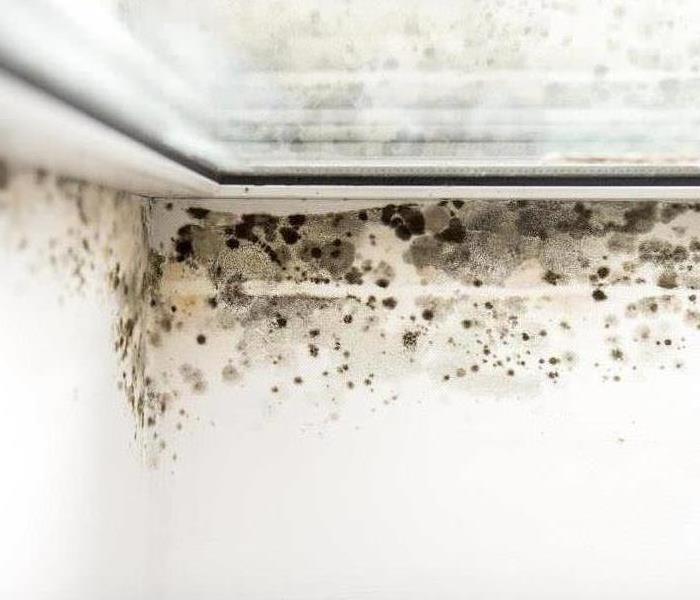 Living by the beach is a dream come true for many homeowners. Unfortunately, beachfront living can come with an unpleasant downside.
Living by the beach is a dream come true for many homeowners. Unfortunately, beachfront living can come with an unpleasant downside.
The Risk of Mold at the Coast
Mold grows best in moist conditions, like the ones right outside your front door while living near coast in California.
Whether you are the brand new owner of a beachfront home or a longtime resident of an oceanside property, you need to take mold seriously.
Here are a few quick tips for preventing mold in your coastal home;
- Remove wet objects right away
- Clean, disinfect and dry
- Increase airflow
- Stop water leaks
- Use dry storage
If left unchecked mold can quickly grow and spread throughout a home which is why it is important to follow these mold prevention tips.
If you are worried about mold in your home don't risk your health or the health of your children or loved ones.
Proper mold removal, mold remediation can eliminate all traces of mold in a beachfront or oceanside home. Don't delay, contact us today, (760) 451-0600 and our professional technicians will help you get rid of any mold problem.
5 Tips for Preventing Mold in an Oceanside Home
Getting rid of mold is one thing, but preventing it is something else. As with other problems of home ownership, the best defense against mold is a good offense.
Taking some proactive steps now can prevent mold in your oceanside or beachfront home later. Here are five timely tips for keeping mold at bay, so you can enjoy the cool ocean breezes and spend more time in the sand.
1. Remove Wet Objects Right Away
From saltwater-soaked beach towels to wet patio furniture cushions, it is important to keep damp items out of your beachfront home. Mold can start growing in an amazingly short period, so every minute you wait is one more minute your home is at risk.
Keeping a hamper by the front door can help you keep those damp items out of your home. Instituting rules for guests and family members can help as well, and go a long way toward keeping your oceanside or beachfront home mold-free.
2. Clean, Disinfect and Dry
Mold loves damp places, and it can grow fast. That is why cleaning and disinfecting your home is so important. Regular cleaning and proper disinfection are always necessary, but it is particularly critical for owners of oceanside and beachfront properties.
Keep your cleaning supplies nearby, disinfect surfaces and always dry everything carefully. Denying mold the damp spots it needs is the best way to protect your home from severe damage.
3. Increase Airflow Throughout Your Home
Improving airflow can go a long way toward keeping mold out of your beachfront or oceanside home, so start by assessing the amount of airflow you currently have and go from there. If the air is flowing beautifully through the entire property, you probably do not have a need to worry.
If the airflow is less than optimal, it is time to get to work. Just adding a fan to the attic or crawlspace can improve airflow a great deal, so that is a good place to get started. Be sure to use the fans you have, like the exhaust fan in your bathroom and kitchen, as doing so will make a mold infestation less likely.
4. Stop Water Leaks Quickly
Water leaks can spark a mold problem like nothing else, so it pays to be vigilant. Beachfront locations are often prone to sudden storms, so take a look around your property as soon as the rainfall has stopped. Check the ceilings for discoloration and damp spots, as these could indicate roof leaks and standing water.
Even the smallest leak, if left untreated, can spark a mold problem, so check for leaks regularly and treat them quickly. Eternal vigilance about water leaks is one of the most efficient ways to stop a mold problem before it starts.
5. Use Dry Storage
Having a dry place to store your belongings is critical when you live in a beachfront property or oceanside home. It is not enough to stack your spare belongings in the attic or hide them in the basement, as improper storage could lead to excess moisture and the growth of mold.
Instead of stacking your belongings willy nilly, take the time to place them in sealed boxes. Do this for your attic, crawlspace, garage and every other storage area in your beachfront or oceanside home. Storing your items properly and in sealed containers can prevent moisture buildup before it starts, and save you some costly repairs.
Maintain Your Home Properly to Avoid Future Repair Costs
Mold remediation can be expensive and is always a complicated and arduous process. That is why it is so important to focus on preventing mold, especially black mold.
Water damage can happen anywhere, but it is far more likely in oceanside and beachfront locations along California's coast. If you want to enjoy all the great things the beach has to offer, do yourself a favor and make mold prevention measures a regular part of your home maintenance. With the right mold remediation plan, you can avoid costly damage and have more time to enjoy your wonderful home.
If you want to enjoy all the great things the beach has to offer, do yourself a favor and make mold prevention measures a regular part of your home maintenance. With the right mold remediation plan, you can avoid costly damage and have more time to enjoy your wonderful home.
However, if you ever do happen to discover a mold problem in your oceanside home, contact us before it spreads.the mold remediation experts at SERVPRO of Falbrook & South Oceanside.
The tips listed above can help you get started, but if the mold is out of hand contact us immediately.
Benefits of Professional Mold Remediation
7/24/2017 (Permalink)
Benefits of Professional Mold Remediation
Respiratory exposure to mold will often cause grave health complications, which is especially true for immunosuppressed individuals. Although the majority of mold species are hardly disease causing, it is hard to tell which one might infest the home or business premises and the extent of damage it is capable of causing. In light of the imminent structural damage caused by mold such as dry rot on wood, it is imperative to hire a mildew restoration company upon suspecting that an infestation of mold in home or even commercial mold damage might occur.
The fungus is capable of growing anywhere and causing mold damage provided that there is sufficient moisture and oxygen. In fact, black mold will grow on any organic matter including insulation, paper, and foods, as well as on wood in which case it could cause dry rot. Leaving a surface with too much moisture unattended for a couple of days will most certainly lead to the growth of mold in home or commercial mold damage. While eradication of mildew spores is virtually impossible, it is crucial to control the moisture to limit the fungus infestation, including mold growth behind wall.
Sources of Moisture
Moisture resulting into mold in home and commercial mold damage will often arise from variable sources, with the most common being uncontrolled humidity during the construction of a building. When a building is tightly sealed while lacking adequate ventilation, there is bound to be a buildup of moisture that will lead to black mold and the accompanying smelly odor. For instance, drywall will usually not facilitate the escape of moisture, thus the presence of mold growth behind wall. Other conditions facilitating mold growth and the subsequent mold damage include leaking roofs, pipe breaks, landscaping problems, unvented combustion appliances and poorly constructed gutters.
The process of Remediation and Mitigation
Any structure in flooded premises ought to be presumed to have mold-containing material, which is especially true if it hasn't been dried within 48 hours. In such instances, it is imperative to take appropriate mold removal and mitigation steps by contacting a mildew restoration company to reduce the risk of exposure. Mold damage mitigation requires an elaborate and systematic mold remediation process that can only be effectively executed by mold removal professionals who reduce the chances of smelly odor through effective deodorization.
The staff from the restoration company will begin the mold removal process by conducting an exposure assessment. This is directed towards determining the extent of mold growth and human exposure to black mold in the affected building as contamination is not always that apparent in flooded area.
Moisture Assessment and Visual Inspection
Professionals in mold removal and mitigation understand that the best method of identifying mold growth, except perhaps mold growth behind wall, is through visual inspection. Such inspection is directed towards determining the most appropriate remedial strategy to be employed for eliminating mold in home or commercial mold damage. This inspection should place emphasis on ceiling tiles, gypsum wallboard, cardboard, paper and cellulosic surfaces.
The professionals also understand that the majority of mildew contamination cannot be detected with the naked eye, which is especially true when it comes to ceilings and interior wall cavities that could be experiencing dry rot or mold growth behind wall. In determining the level of fungus infestation in such areas, these experts are sometimes compelled to approximate the sum of square feet of the affected structural materials, which is not an easy task.
Professional judgment will particularly come in handy when establishing such less quantifiable factors as location of the mold growth as well as use and function of the building. They will also check the ventilation system for possible dampness while inspecting the HVAC system for contamination, in the presence of which they might employ deodorization to get rid of the smelly odor if any. Besides, only a professional in mold removal can sufficiently comprehend the guidelines and algorithms for remediation provided by the U.S. Environmental Protection Agency.
Apart from possessing the requisite skills for remediation including deodorization for effective removal of the smelly odor, professionals in black mold mitigation will come with the appropriate equipment needed for effective assessment. Such include moisture meters a borescope and humidity meters for determining the moisture content of a building that could lead to mold damage.
Since the fungus is capable of infesting such hard to reach areas like inside walls, crawl places, and ceiling plenums among other tight areas, the professionals from a restoration company employ a borescope to eliminate the need to drill or cut walls in establishing mold growth behind wall. They also come with the required protective gear, including goggles, dust filter and gloves, which especially come in handy during deodorization to eradicate smelly odor and removal of the dry rot from the wooden structures.
Visit http://www.SERVPROfallbrooksouthoceanside.com for more information on mold damage.
Steps For Proper Mold Remediation
6/29/2017 (Permalink)
Steps For Proper Mold Remediation
Mold damage is never an issue that people like having to address. Whether it is mold in the home or commercial mold damage, it needs to be taken care of properly. There are many steps to taking care of a mold problem and to prevent it from spreading means doing the correct mode of treatment before it spreads to make sure it has been fully eradicated. A professional mold mitigation company knows what to look for and can formulate a plan to permanently get rid of any mold, mildew or fungus problem that their clients have. Once they finish the proper mold removal they will use a good deodorization technique to get rid of any leftover smelly odor.
Learn About Moisture In Mold Removal And Mitigation
Assessing the amount of mold damage in a home or business is more about finding the cause of the problem and less about just the mold, mildew or fungus that is visible. Mold is a very invisible intruder and can be lurking in small, unknown spaces that you cannot see until it has grown out of control. This kind of mold behavior requires a special thought process. It is important to realize first and foremost that all mold problems arise from a moisture or water problem. To become a master at mold removal, there has to be a lot of knowledge in how and where water and moisture gets inside a home or business.
Document The Mold Damage And Create Remediation Plan
Before the process of remediation or mitigation is started, a thorough documentation needs to be created first. This should include things like what types of mold, fungus and mildew are present. Will deodorization be necessary once the process is completed for a smelly odor? Every detail is important when forming a mold removal plan for mold in a home or a commercial mold damage problem. Along with these items, a list of what procedures are going to be completed, how they will be done and when the expected completion date is should also be included on the list and given to the client.
Calculate Extent Of Mold Damage Contamination
Mold doesn't always grow in one contained area. Mold spores can be spread easily through the air. Because of this, all heating and air ducts should be checked for contamination as well. If the extent of mold is big and covers a large area, then it may be necessary to have the homeowners or business owners leave the residence for a while until the mold has been cleaned up completely. Depending on the extent of the mildew, fungus and mold in a home or for a commercial mold damage issue, the mitigation process might take a while. Also, once the mold has been completely taken care of, there might be a leftover smelly odor which will need a lot of deodorization.
Basic Mold Remediation Cleanup Process
Mold remediation will always involve both cleaning up the existing mold while avoiding any exposure or contamination of other areas not yet exposed. This is especially important when getting rid of mold in a home or mitigation of commercial mold damage where people are present on a daily basis.
•Repair Cause Of Water Damage- This is the important first step so that no more mold begins to grow. Find and fix all areas where water or moisture may be coming from.
•Isolate Contamination- All access to other areas should be closed off from the room or rooms that are contaminated with mold so that it doesn't spread.
•Remove Damaged Materials- All wet and moldy items should be removed in plastic bags. They need to be disposed up properly or cleaned in an outside area thoroughly before being taken back inside.
•Cleanup- Once everything is removed and the contaminated area is closed off, it is time for the mold removal process to begin. All mold should be treated with the proper cleaning solutions and any vacuuming should be done with a HEPA vacuum to keep mold spores from being transferred. After the initial cleanup is complete, the deodorization process can be completed in order to get rid of any leftover smelly odor.
Visit http://www.SERVPROfallbrooksouthoceanside.com for more information on mold damage.
How to Eliminate Molds from a Home
6/2/2017 (Permalink)
How to Eliminate Molds from a Home
Molds are a problem in many residential and commercial buildings. They mostly grow and feed by organic matter, and they need a warm and moist environment for then to live. Molds in homes often bring a smelly odor, and one might have to conduct constant deodorization. Areas that are mainly affected by mold damage include carpets, framing, floors, walls, tackles strips, and ceilings. Cleaners will often notice a powdery white fore that has a smelly odor in these places. At many times, mildew growth occurs after water damage due to floods or rain. Some places take excessive time to dry up, and therefore, they offer room for fungus and molds in homes. Homeowners can contact commercial mold damage control professionals to help in conducting the remediation process to prevent them from contaminating other places.
Mold removal should be done in the correct manner so as to avoid unnecessary expenses. One can handle the damage that is caused by the molds, fungus, and mildew by preventing them from spreading by killing them, removing the dead material, and protecting the cleaned area from being affected by fungus and molds in future. The following steps should be followed by any individual who would like to ensure mitigation of mold growth in homes without hiring commercial mold damage experts.
1. Inspection and testing for Fungus and Mold Presence. The homeowners conduct a thorough inspection to determine the areas that have visible mildew and those that are in hidden spaces. A hygrometer, humidity meter, and moisture meter can help in detecting places that are hard to find. One can also notice them because of their smelly odor. Finding the affected area is the first step of mitigation.
2. Containment. The infested area should be entirely covered using a 6 millimeter thick clear plastic bag to mitigate the movement and contamination of the mold spores in other parts of the house. This is a critical remediation step since one may have to hire commercial mold damage experts if the problem is out of control.
3. Ensure Body Protection. Individuals who conduct mold removal should wear a breathing mask with proper organic vapor filters that are classified as P100. One should also have a protective body suit that has a parka hood, disposable vinyl gloves, and boots. This assists in mitigation the chances of being affected by chemicals and the molds in the home.
4. Use proper Enzyme Treatment. There are various mold-eating enzyme treatments, and an example is Sporicidin Disinfectant Solution (SDS). This chemical can be sprayed using aerosol cans or a cheap fogging machine to fog the whole house. SDS is among the enzyme-based disinfectant cleaners that have been approved by the U.S Environmental Protection Agency. It ensures mitigation of fungi, bacteria, and mold damage by preventing their growth.
5. Vacuuming and Air Scrubbing. One should use high-efficiency particulate air (HEPA) scrubbers after spraying the enzymes. The HEPA machine should be an industrial size to increase efficiency. The negative pressure that is exerted assists in collecting the airborne fungus and mold spores that are on the site. One can hire the commercial mold damage professionals is he or she cannot access a HEPA vacuum.
6. Physically Removal of the Molds. The visible mold growths should also be removed. This can be done by using different equipment such as wire brushes and sanding blocks for timber. Curtains and carpeting can be discarded or washed if the mold damage is not severe.
7. Proper dumping of Moldy Stuff. The infested material should be disposed of in a safe manner during mold removal. They can be carried in a 6 millimeter think garbage disposal bag. One should then clean the outside of the bag with hydrogen peroxide or a suitable detergent to remove any mold deposits. This will enable easy transportation without infecting other areas of the building.
8. Covering Timber Frames. After cleaning wood surfaces, the exposed parts should be painted and remediated with glossy latex enamel paint that has been mixed with a fungicide. The most preferred treatment to eliminate mildew and insects is Tim-Bor, which is an APA registered fungicide. The glossy latex protects penetration of water. Deodorization of the surfaces should also be done to eliminate any smelly odor.
9. Cleaning HVAC Ducts. The growth of molds in homes is often caused by lack of proper aeration. The presence of fungi contaminates heating, air conditioning, and ventilation dust and this leads to smelly odors in homes. Disinfection and deodorization should be done well as a remediation precaution for mold damage.
By following all the above steps for mold removal and remediation, people can have homes that are free of mildew. The growths often make all the areas that they affect to have a bad odor, and therefore, it is necessary to conduct some deodorization procedures.
Visit http://www.SERVPROfallbrooksouthoceanside.com for more information on mold removal and remediation.
Mold Remediation and Removal Services
4/24/2017 (Permalink)
Mold Remediation and Removal Services
If someone thinks they may have mold in their home, it's incredibly important to have this checked out by an environmental hygienist. This article will explain the differences between fungus, mildew, and mold as well as the microbial growth that contributes to it. This article will also highlight the mold cleanup process and mitigation techniques used to avert this potentially hazardous matter.
It's first important to note, that just because someone finds microbial growth, it doesn't necessarily mean there's a hazard present. Many types of fungus and mold are completely harmless and some even beneficial, as used in the classic example of penicillin. The fungus is simply a species of plant of the fungi class.
While mitigation efforts can certainly be taken on by home or business owners as a method of prevention, an environmental hygienist is the only one who can determine the threat level and if the microbial growth is even anything needing mildew or mold cleanup. Even the Center for Disease Control (CDC), warns that special equipment for analysis and handling is required to carry out this process and mildew or mold cleanup should never be handled by someone who isn't professionally trained and licensed.
Once the environmental hygienist is able to assess the matter, he or she will create a plan to complete the mold cleanup and how to take steps for mitigation so the problem doesn't come back. Nobody wants to have to deal with this problem more than once, especially if it's already destroyed personal belongings or has caused health consequences for the home or business owner.
After the environmental hygienist takes care of the problem (if one is present), they will thoroughly provide a mitigation analysis and determine what the best course of action such as waterproofing and recognizing the signs of mold and mildew for the home or business owner. It can't be stressed enough that only a qualified professional can accurately diagnose and recommend adequate treatment and conduct mold cleanup efforts.
As previously stated, finding microbial growth or fungus isn't a reason to panic immediately unless it's already started causing problems. If there are problems such as exacerbated asthma or people getting sick regularly, they need to be addressed immediately. While most people know the basics of mold and the smell of mildew if they see anything that is growing anywhere that it shouldn't be, and especially if the color is black, they must call an environmental hygienist immediately to assess the situation. They will be able to provide the home or business owner with reasonable estimates to provide mold cleanup and mitigation services. Visit http://www.SERVPROfallbrooksouthoceanside.com for more information on mold removal and remediation.
Mold Removal and Remediation in Fallbrook, Oceanside, CA and CO
3/24/2017 (Permalink)
Mold Removal and Remediation in Fallbrook, Oceanside, CA and CO
In Fallbrook, Oceanside, CA as well as CO, there are many varieties of these types of moldy growth, but every single species requires water or moisture to grow, so controlling moisture issues inside is what allows this type of growth to exist in homes without necessarily expanding into an issue. However, with even a small but constant rate of moisture, the organic destroying capabilities of certain microbial growths can become an issue that can make a home or business impossible to exist in for any amount of time. This destructive capability can be produced by moldy type substances and mildew that have no detrimental health side effects. These microbial substances are an integral section of the environment, and their role in the natural world is to biodegrade organic matter like dead trees and other dead organic material.
However, when these natural organic substances migrated indoors, humans understood quickly that they are a natural part of the environment that should be avoided. Moldy organisms, mildew and fungus multiply by releasing millions of microscopic spores. These invisible spores exist in outdoor and indoor air. This microbial growth migrates indoors when the spores affix themselves to surfaces that have at least one of the conditions necessary for them to survive which is organic material. Outside, this material would be dead leave and trees, but most construction material indoors is organic material on which these spores can survive. The outdoor material would naturally have some measure of moisture which is the second element that these spores need not only to survive, but to proliferate greatly.
However, if the cleanup and removal is not done completely, the issues will recur with great frequency. This is a problem for large moldy growth issues, but it is also a problem for the common business or homeowner that would like an odor to be eliminated completely without recurrence.
Additionally, not all of these growths can be eradicated with the same mold removal method or chemical. This means that the problem must be first identified properly by an environmental hygienist.
An environmental hygienist can solve the problem completely by first identifying the troubling issue, and then institution of an eradication and mold removal process suitable for the particular growth.
This will prevent a lot of unnecessary expense and time by fixing the problem correctly the first time. For more information on mold remediation and removal, visit http://www.SERVPROfallbrooksouthoceanside.com.
Recovering from Mold Damage in Fallbrook, Oceanside, CA
2/21/2017 (Permalink)
Recovering from Mold Damage in Fallbrook, Oceanside, CA
Finding mold in your property is not something that is going to affect you as long as you contact the right group of people. Microbial growth is something that can have long-term negative effects on anyone who allows it to exist within the premises of their homes for too long. An environmental hygienist is someone who will be able to go over to your property to take a look at what if any issues may exist so that they will be able to make some recommendations regarding the issue(s) that may require mold remediation.
Mold remediation services are often required for homeowners who have had fungus grow on their properties. Oceanside, CA offers the best services of mildew removal and should not be considered as one's "last resort" as the work that they provide can have quite positive effects on both the values of your home and your health. By contacting one of the specialists of mold removal, you may set up an appointment during a time that fits around your own schedule, thus offering a flexible scheduling plan that you can work with. The city of Oceanside and surrounding CO in CA can have times when humidity may be a factor in the weather. Such climates are opportunities of growth for mold and fungus. By eliminating such opportunities, it is highly recommended for you to contact mold removal services who you give you the guidance and services that you will need to attain a property that is safe for you to live in without having to worry about your health. Fallbrook, CA is also near the ocean, thus, being prone to having humid days and potential instances of microbial growth. Any time moisture can touch the surfaces of a home's property, there will be opportunities of growth for mildew. Such cases will require the attention of an environmental hygienist in Fallbrook CO as soon as possible.
One may be under the impression that they can simply take care of a bacterial growth issue within their property's premises at a later time from when they first detect it, however, that is not the recommended course of action for anyone to take as it can spread within the premises rather quickly. The actions that you take towards achieving a better functioning property will enable you to live a life free of stress and worries of being harmed by bacteria lingering around your living space. Please contact the group of professionals who are able to provide you with assistance and guidance in not only improving the conditions of your home through sanitary tasks, but also by providing you with guidance in pertinence to how you can keep your property free of microbial growth. Bacteria is not a joking matter as it has been the cause of many severe cases of illnesses. It is not something to "test" in any sense as you may greatly regret it if it is to put you in the doctor's office at some point in time. Make the phone call that may be required to put you at ease. Visit http://www.SERVPROfallbrooksouthoceanside.com if you suspect mold in your property.

 24/7 Emergency Service
24/7 Emergency Service











